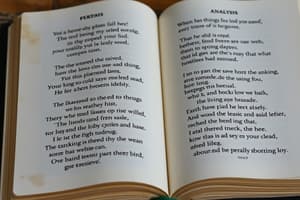Podcast
Questions and Answers
Which stanza consists of four lines?
Which stanza consists of four lines?
- Couplet
- Quatrain (correct)
- Octave
- Sestet
What is enjambment in poetry?
What is enjambment in poetry?
- A run-on line where the sense carries over (correct)
- A specific meter in poetry
- A form of rhyme
- A pause at the end of a line
What type of rhyme occurs between the final word of one line and the final word of another line?
What type of rhyme occurs between the final word of one line and the final word of another line?
- True rhyme
- Eye rhyme
- Slant rhyme
- End rhyme (correct)
What is a volta in a poem?
What is a volta in a poem?
Which poetic foot consists of one stressed syllable followed by one unstressed syllable?
Which poetic foot consists of one stressed syllable followed by one unstressed syllable?
What is a defining characteristic of a pastoral poem?
What is a defining characteristic of a pastoral poem?
Which of the following best describes the focus of analyzing the speaker in a poem?
Which of the following best describes the focus of analyzing the speaker in a poem?
What is essential to include in the introductory paragraph of a poem analysis?
What is essential to include in the introductory paragraph of a poem analysis?
Which poetic form is characterized by 14 lines written in iambic pentameter?
Which poetic form is characterized by 14 lines written in iambic pentameter?
What is an effect of using poetic devices such as figurative language and sound in poetry?
What is an effect of using poetic devices such as figurative language and sound in poetry?
Flashcards
Couplet
Couplet
A stanza consisting of 2 lines, often rhymed.
Enjambment
Enjambment
A run-on line of poetry that carries over into the next line without a pause.
Iamb
Iamb
A metrical foot with an unstressed syllable followed by a stressed syllable.
True rhyme
True rhyme
Signup and view all the flashcards
Volta
Volta
Signup and view all the flashcards
First Reading Focus Questions
First Reading Focus Questions
Signup and view all the flashcards
Poetic Devices
Poetic Devices
Signup and view all the flashcards
Pastoral
Pastoral
Signup and view all the flashcards
Sonnet
Sonnet
Signup and view all the flashcards
Thesis Statement
Thesis Statement
Signup and view all the flashcards
Study Notes
Poetry Analysis
- Focus Questions for Reading:
- What happens in the poem?
- What images do you visualize?
- What thoughts does it evoke?
- What is your emotional response?
Poetry Analysis Process
-
Pre-Reading: Examine the title and form (if apparent).
-
Focus 1: Literal Subject: Identify the poem's literal subject.
-
Focus 2: Speaker & Attitude: Analyze the speaker's attitude towards the subject.
-
Focus 3: Poetic Devices: Identify how devices shape tone, mood, and meaning. Consider figurative language, structure, and sound devices.
-
Introductory Paragraph: The last sentence must be the thesis statement or main claim.
Poetic Forms
-
Pastoral: Lyric poems praising the rustic life, often featuring shepherds.
-
Sonnet: 14-line poems in iambic pentameter with a specific rhyme scheme (Petrarchan, Shakespearean, Spenserian).
-
Stanzas:
-
Couplet: 2 lines
-
Quatrain: 4 lines
-
Sestet: 6 lines
-
Octave: 8 lines
-
Volta: A shift in the poem's direction or thought.
Poetic Structure
- Syntax:
- End-stopped: Lines with pauses at the end, marked by punctuation.
- Caesura: Longer pauses, often near the line's middle, with punctuation.
- Enjambment: Run-on lines where the sense carries over to the next line.
Poetic Rhythm
-
Meter: Regular rhythmic unit.
-
Poetic Foot: Group of stressed and unstressed syllables
-
Iamb: Unstressed-stressed ("hello")
-
Trochee: Stressed-unstressed ("pickle")
-
Meter Types:
-
Tetrameter: 4 feet per line
-
Pentameter: 5 feet per line
Poetic Sound Devices
-
Rhyme:
-
True Rhyme: Identical vowel and consonant sounds after the final stressed syllable
-
Eye Rhyme: Words spelled alike but pronounced differently
-
Slant Rhyme: Close but not exact rhyme correspondence (assonance or consonance)
-
Alliteration: Repetition of initial consonant sounds.
-
Assonance: Repetition of vowel sounds.
-
Consonance: Repetition of consonant sounds within words (not at the beginning).
Studying That Suits You
Use AI to generate personalized quizzes and flashcards to suit your learning preferences.




